Spatial and Temporal Characterization of the Development and Pollution Emissions of Key Heavy Metal-Related Industries in Typical Regions of China: A Case Study of Hunan Province
Abstract
1. Introduction
2. Materials and Methods
2.1. Study Area
2.2. Study Data
2.3. Study Methods
3. Results
3.1. Development Characteristics of Heavy Metal-Related Industries in Hunan Province
3.2. Characteristics of Pollution Emissions from Heavy Metal-Related Industries
3.3. Environmental Impacts of Pollution Emissions from Heavy Metal-Related Industries
4. Discussion
4.1. Development and Pollution Emissions from Heavy Metal-Related Industries
4.2. Environmental Impacts of Heavy Metal Pollution Discharge
4.3. Limitations
5. Conclusions
Author Contributions
Funding
Institutional Review Board Statement
Informed Consent Statement
Data Availability Statement
Conflicts of Interest
Abbreviations
| HMIs | heavy metal-related industries |
| NMDI | nonferrous metal mining and dressing industry |
| NSRI | nonferrous metal smelting and rolling industry |
| MPMI | metal product manufacturing industry |
| CPMI | chemical product manufacturing industry |
| LFMI | leather and footwear manufacturing industry |
| EMEI | electrical machinery and equipment manufacturing industry |
| ESPI | electric power production and supply industry |
| SDGs | United Nations Sustainable Development Goals |
Appendix A
Appendix A.1
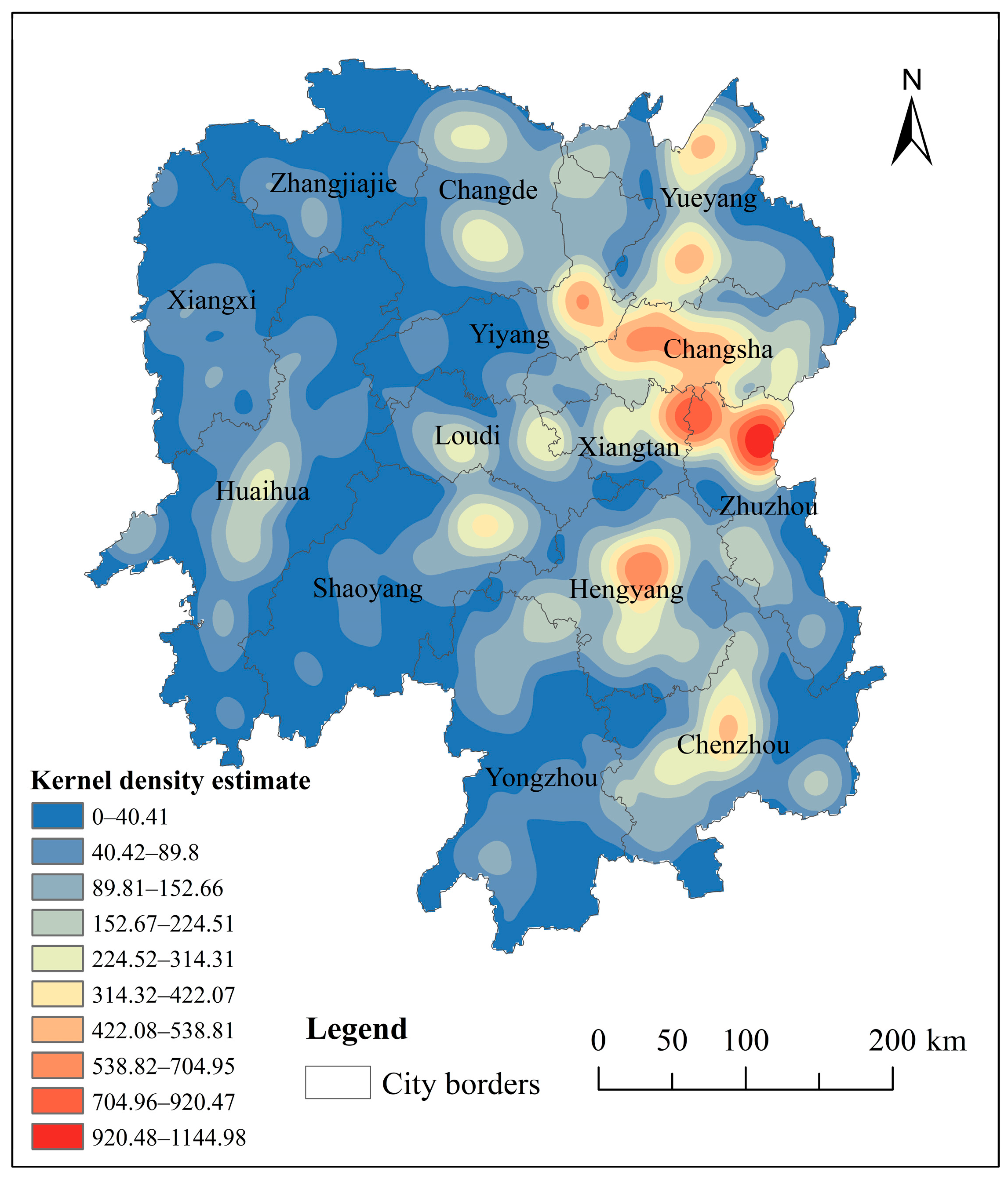
Appendix A.2
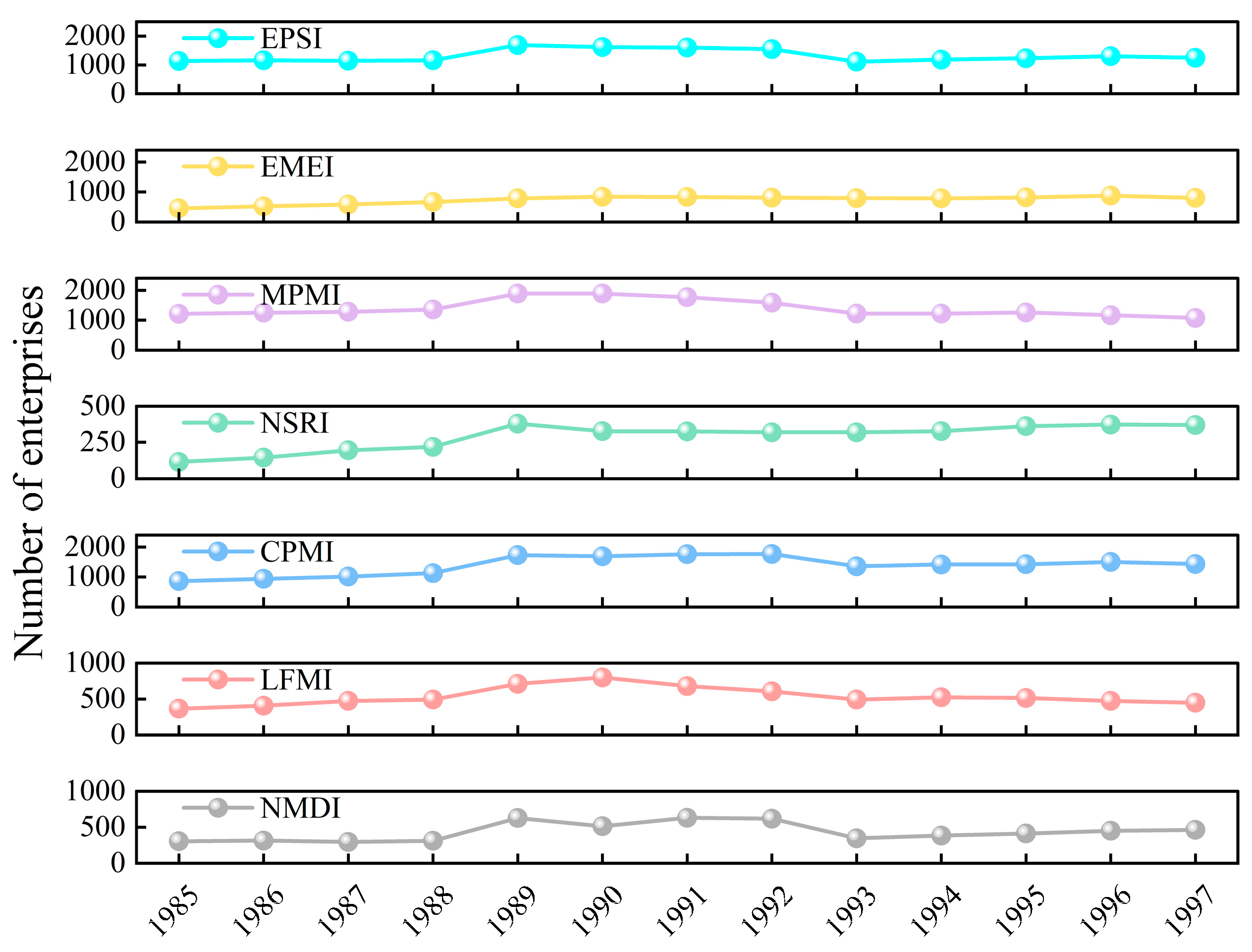
Appendix A.3
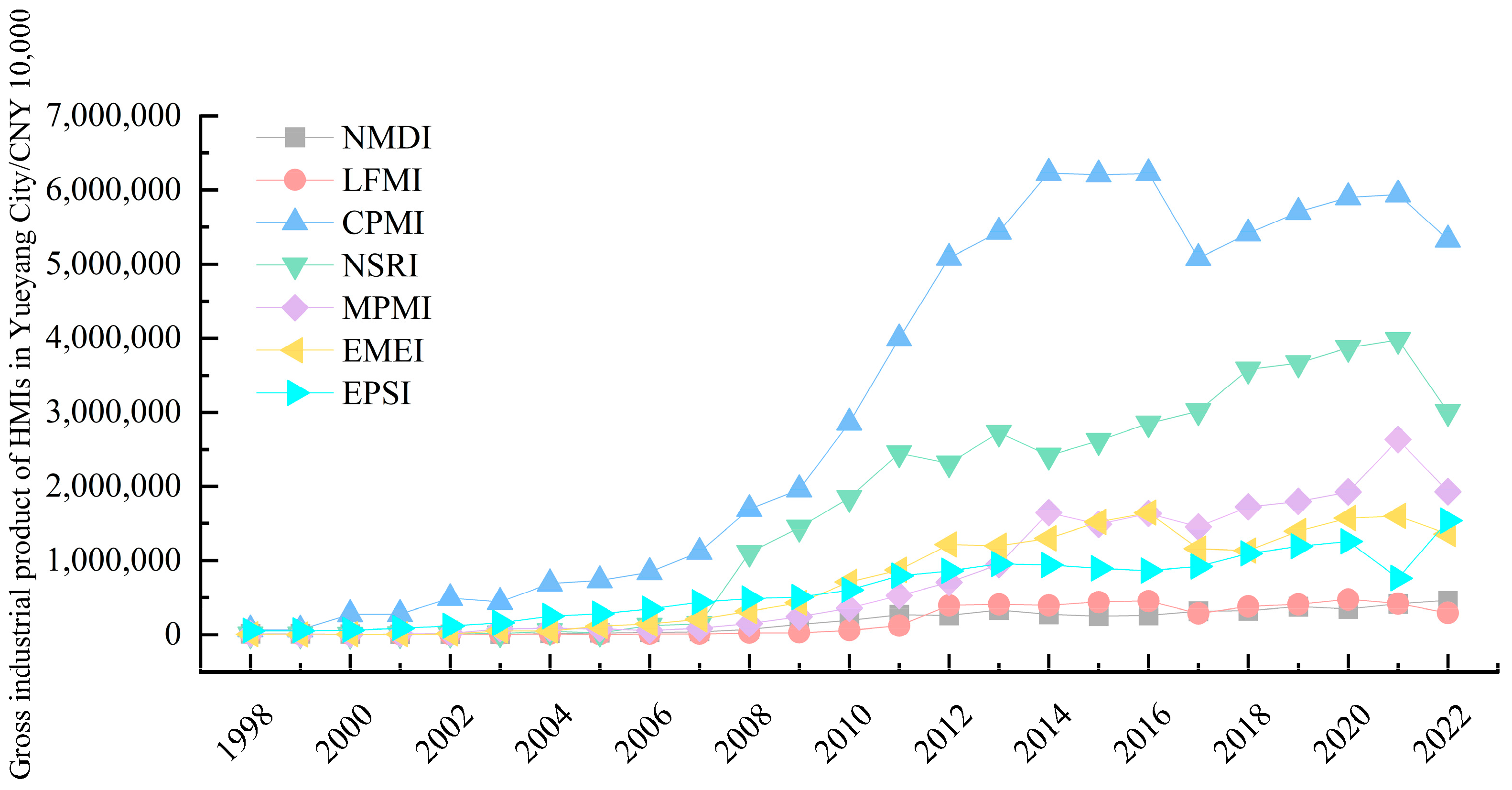
References
- He, B.; Yun, Z.; Shi, J.; Jiang, G. Research progress of heavy metal pollution in China: Sources, analytical methods, status, and toxicity. Chin. Sci. Bull. 2013, 58, 134–140. [Google Scholar] [CrossRef]
- Zhang, J.; Sun, X.; Deng, J.; Li, G.; Li, Z.; Jiang, J.; Wu, Q.; Duan, L. Emission characteristics of heavy metals from a typical copper smelting plant. J. Hazard. Mater. 2022, 424, 127311. [Google Scholar] [CrossRef]
- Jacob, J.M.; Karthik, C.; Saratale, R.G.; Kumar, S.S.; Prabakar, D.; Kadirvelu, K.; Pugazhendhi, A. Biological approaches to tackle heavy metal pollution: A survey of literature. J. Environ. Manag. 2018, 217, 56–70. [Google Scholar] [CrossRef] [PubMed]
- Qi, D.; Chen, H.; Hu, L.; Sun, J. Multimethod Analysis of Heavy Metal Pollution and Source Apportionment in a Southeastern Chinese Region. Appl. Sci. 2024, 14, 10559. [Google Scholar] [CrossRef]
- Liu, Q.; Liu, M.; Wang, Z.; Yan, F.; Ma, Y.; Shen, W. A novel intelligent manufacturing mode with human-cyber-physical collaboration and fusion in the non-ferrous metal industry. Int. J. Adv. Manuf. Technol. 2022, 119, 549–569. [Google Scholar] [CrossRef]
- Hu, B.; Shao, S.; Ni, H.; Fu, Z.; Hu, L.; Zhou, Y.; Min, X.; She, S.; Chen, S.; Huang, M.; et al. Current status, spatial features, health risks, and potential driving factors of soil heavy metal pollution in China at province level. Environ. Pollut. 2020, 266, 114961. [Google Scholar] [CrossRef]
- Yan, F.; Li, N.; Wang, J.; Wu, H. Ecological footprint model of heavy metal pollution in water environment based on the potential ecological risk index. J. Environ. Manag. 2023, 344, 118708. [Google Scholar] [CrossRef]
- Li, K.; Sun, R.; Guo, G. Spatial and temporal variations in environmental impacts of heavy metal emissions from China’s non-ferrous industry: An enterprise-specific assessment. Sci. Total Environ. 2024, 929, 172770. [Google Scholar] [CrossRef] [PubMed]
- Huang, Y.; Zhou, B.; Li, N.; Li, Y.; Han, R.; Qi, J.; Lu, X.; Li, S.; Feng, C.; Liang, S. Spatial-temporal analysis of selected industrial aquatic heavy metal pollution in China. J. Clean. Prod. 2019, 238, 117944. [Google Scholar] [CrossRef]
- Shi, H.; Wang, S.; Xu, X.; Huang, L.; Gu, Q.; Liu, H. Spatial distribution and risk assessment of heavy metal pollution from enterprises in China. J. Hazard. Mater. 2024, 480, 136147. [Google Scholar] [CrossRef]
- Wang, Y.; Duan, X.; Wang, L. Spatial distribution and source analysis of heavy metals in soils influenced by industrial enterprise distribution: Case study in Jiangsu Province. Sci. Total Environ. 2020, 710, 134953. [Google Scholar] [CrossRef] [PubMed]
- Aborisade, M.A.; Feng, A.; Oba, B.T.; Kumar, A.; Battamo, A.Y.; Huang, M.; Chen, D.; Yang, Y.; Sun, P.; Zhao, L. Pyrolytic synthesis and performance efficacy comparison of biochar-supported nanoscale zero-valent iron on soil polluted with toxic metals. Arch. Agron. Soil Sci. 2023, 69, 2249–2266. [Google Scholar] [CrossRef]
- Aborisade, M.A.; Geng, H.; Oba, B.T.; Kumar, A.; Ndudi, E.A.; Battamo, A.Y.; Liu, J.; Chen, D.; Okimiji, O.P.; Ojekunle, O.Z.; et al. Remediation of soil polluted with Pb and Cd and alleviation of oxidative stress in Brassica rapa plant using nanoscale zerovalent iron supported with coconut-husk biochar. J. Plant Physiol. 2023, 287, 154023. [Google Scholar] [CrossRef]
- Tellman, B.; Sullivan, J.A.; Kuhn, C.; Kettner, A.J.; Doyle, C.S.; Brakenridge, G.R.; Erickson, T.A.; Slayback, D.A. Satellite imaging reveals increased proportion of population exposed to floods. Nature 2021, 596, 80–86. [Google Scholar] [CrossRef]
- Hao, H.; Liu, F.; Huang, Z.; Lv, Y.; Chen, W.; Ge, D. Spatial Distribution, Contamination Feature, and Health-Risk Assessment of Heavy Metals and Metalloids in Farmland Soil in the Hunan Province, China. J. Environ. Eng 2022, 148, 4022053. [Google Scholar] [CrossRef]
- Jiang, Z.; Guo, Z.; Peng, C.; Liu, X.; Zhou, Z.; Xiao, X. Heavy metals in soils around non-ferrous smelteries in China: Status, health risks and control measures. Environ. Pollut. 2021, 282, 117038. [Google Scholar] [CrossRef] [PubMed]
- Li, H.; Yao, J.; Min, N.; Sunahara, G.; Zhao, Y.; Duran, R. Considering the bioavailability and bioaccessibility of metal(loid)s for risk assessment of soils affected by different non-ferrous metal activities in Southwest China. J. Hazard. Mater. 2024, 472, 134527. [Google Scholar] [CrossRef]
- Huang, Y.; Wang, L.; Wang, W.; Li, T.; He, Z.; Yang, X. Current status of agricultural soil pollution by heavy metals in China: A meta-analysis. Sci. Total Environ. 2019, 651, 3034–3042. [Google Scholar] [CrossRef]
- Liu, L.; Wang, J.; Zhai, J.; Yan, D.; Lin, Z. Regional disparities and technological approaches in heavy metal remediation: A comprehensive analysis of soil contamination in Asia. Chemosphere 2024, 366, 143485. [Google Scholar] [CrossRef]
- Wei, C.; Lei, M.; Chen, T.; Zhou, C.; Gu, R. Method on site-specific source apportionment of domestic soil pollution across China through public data mining: A case study on cadmium from non-ferrous industries. Environ. Pollut. 2022, 295, 118605. [Google Scholar] [CrossRef]
- Qin, G.; Niu, Z.; Yu, J.; Li, Z.; Ma, J.; Xiang, P. Soil heavy metal pollution and food safety in China: Effects, sources and removing technology. Chemosphere 2021, 267, 129205. [Google Scholar] [CrossRef] [PubMed]
- Li, X.; Zhao, Z.; Yuan, Y.; Wang, X.; Li, X. Heavy metal accumulation and its spatial distribution in agricultural soils: Evidence from Hunan province, China. RSC Adv. 2018, 8, 10665–10672. [Google Scholar] [CrossRef]
- Zhang, B.; Su, Y.; Shah, S.Y.A.; Wang, L. Uncertainty Evaluation of Soil Heavy Metal(loid) Pollution and Health Risk in Hunan Province: A Geographic Detector with Monte Carlo Simulation. Toxics 2023, 11, 1006. [Google Scholar] [CrossRef] [PubMed]
- Yu, Y.; Luo, H.; He, L.; Liu, W.; Xu, R.; Zhang, L.; Dong, G.; Wang, Y.; Wu, G.; Wei, F. Level, Source, and Spatial Distribution of Potentially Toxic Elements in Agricultural Soil of Typical Mining Areas in Xiangjiang River Basin, Hunan Province. Int. J. Environ. Res. Public Health 2020, 17, 5793. [Google Scholar] [CrossRef]
- Wang, S.; Zhang, Y.; Cheng, J.; Li, Y.; Li, F.; Li, Y.; Shi, Z. Pollution Assessment and Source Apportionment of Soil Heavy Metals in a Coastal Industrial City, Zhejiang, Southeastern China. Int. J. Environ. Res. Public Health 2022, 19, 3335. [Google Scholar] [CrossRef]
- Li, H.; Yao, J.; Sunahara, G.; Min, N.; Li, C.; Duran, R. Quantifying ecological and human health risks of metal(loid)s pollution from non-ferrous metal mining and smelting activities in Southwest China. Sci. Total Environ. 2023, 873, 162364. [Google Scholar] [CrossRef]
- Li, H.; Yao, J.; Min, N.; Chen, Z.; Li, M.; Pang, W.; Liu, B.; Cao, Y.; Men, D.; Duran, R. Comprehensive evaluation of metal(loid)s pollution risk and microbial activity characteristics in non-ferrous metal smelting contaminated site. J. Clean. Prod. 2022, 344, 130999. [Google Scholar] [CrossRef]
- Ni, S.; Liu, G.; Zhao, Y.; Zhang, C.; Wang, A. Distribution and Source Apportionment of Heavy Metals in Soil around Dexing Copper Mine in Jiangxi Province, China. Sustainability 2023, 15, 1143. [Google Scholar] [CrossRef]
- Hao, W.; Wang, Y.; Wang, X.; Lin, M.; Mao, K.; Hao, S. Analysis of TDS and Heavy Metal Pollution Characteristics in Groundwater of Typical Antimony Mining Areas in Hunan. Water 2024, 16, 3453. [Google Scholar] [CrossRef]
- Cui, Y.; Bai, L.; Li, C.; He, Z.; Liu, X. Assessment of heavy metal contamination levels and health risks in environmental media in the northeast region. Sustain. Cities Soc. 2022, 80, 103796. [Google Scholar] [CrossRef]
- Chai, L.; Li, H.; Yang, Z.; Min, X.; Liao, Q.; Liu, Y.; Men, S.; Yan, Y.; Xu, J. Heavy metals and metalloids in the surface sediments of the Xiangjiang River, Hunan, China: Distribution, contamination, and ecological risk assessment. Environ. Sci. Pollut. Res. 2017, 24, 874–885. [Google Scholar] [CrossRef] [PubMed]
- Izydorczyk, G.; Mikula, K.; Skrzypczak, D.; Moustakas, K.; Witek-Krowiak, A.; Chojnacka, K. Potential environmental pollution from copper metallurgy and methods of management. Environ. Res. 2021, 197, 111050. [Google Scholar] [CrossRef] [PubMed]
- Yang, J.; Han, Z.; Yan, Y.; Guo, G.; Wang, L.; Shi, H.; Liao, X. Neglected pathways of heavy metal input into agricultural soil: Water–land migration of heavy metals due to flooding events. Water Res. 2024, 267, 122469. [Google Scholar] [CrossRef]
- Weber, A.; Wolf, S.; Becker, N.; Märker-Neuhaus, L.; Bellanova, P.; Brüll, C.; Hollert, H.; Klopries, E.; Schüttrumpf, H.; Lehmkuhl, F. The risk may not be limited to flooding: Polluted flood sediments pose a human health threat to the unaware public. Environ. Sci. Eur. 2023, 35, 58. [Google Scholar] [CrossRef]
- Peng, D.; Liu, Z.; Su, X.; Xiao, Y.; Wang, Y.; Middleton, B.A.; Lei, T. Correction: Spatial distribution of heavy metals in the West Dongting Lake floodplain, China. Environ. Sci. Process. Impacts 2020, 22, 136. [Google Scholar] [CrossRef]
- Klok, C.; Goedhart, P.W.; Vandecasteele, B. Field effects of pollutants in dynamic environments. A case study on earthworm populations in river floodplains contaminated with heavy metals. Environ. Pollut. 2007, 147, 26–31. [Google Scholar] [CrossRef]
- Crawford, S.E.; Brinkmann, M.; Ouellet, J.D.; Lehmkuhl, F.; Reicherter, K.; Schwarzbauer, J.; Bellanova, P.; Letmathe, P.; Blank, L.M.; Weber, R.; et al. Remobilization of pollutants during extreme flood events poses severe risks to human and environmental health. J. Hazard. Mater. 2022, 421, 126691. [Google Scholar] [CrossRef]

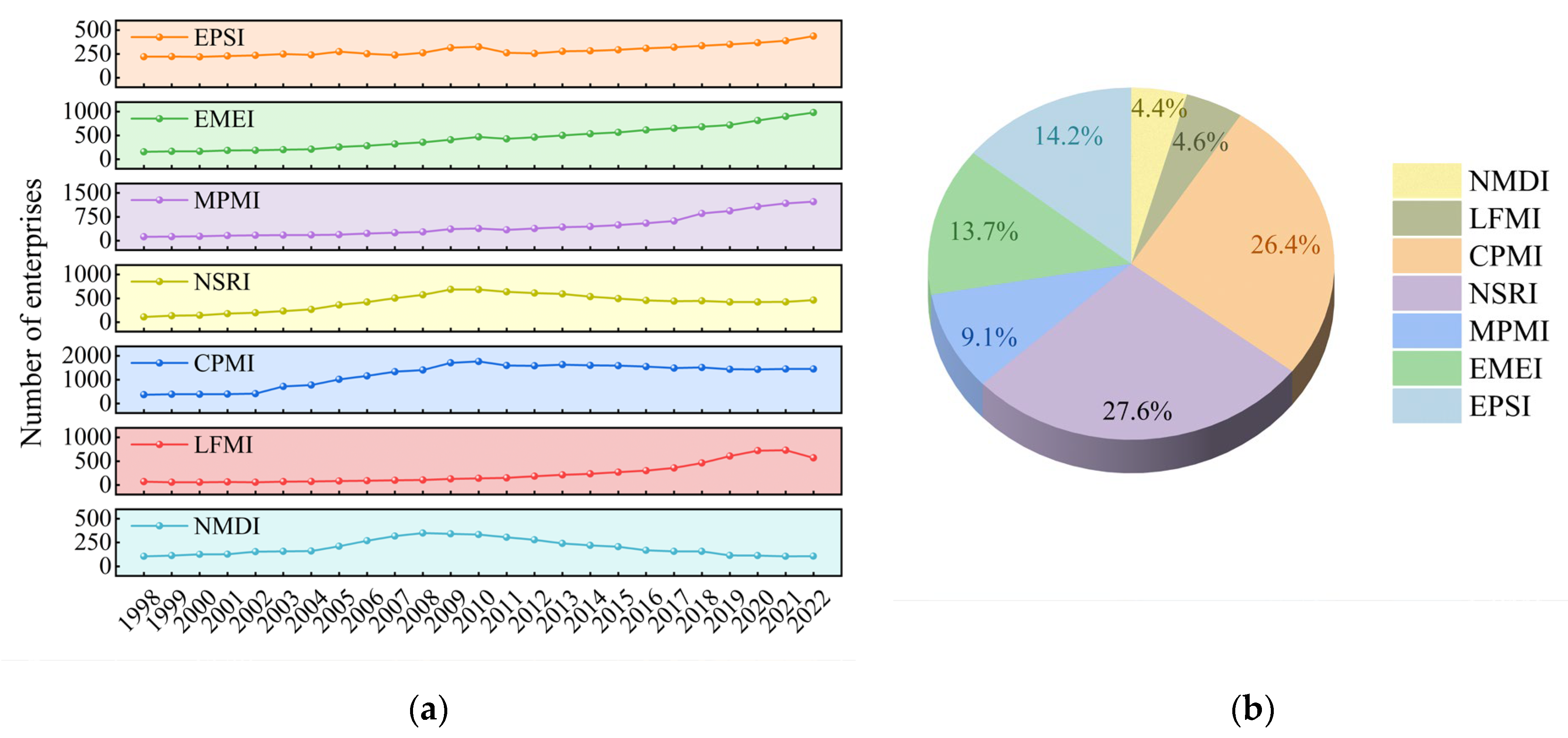
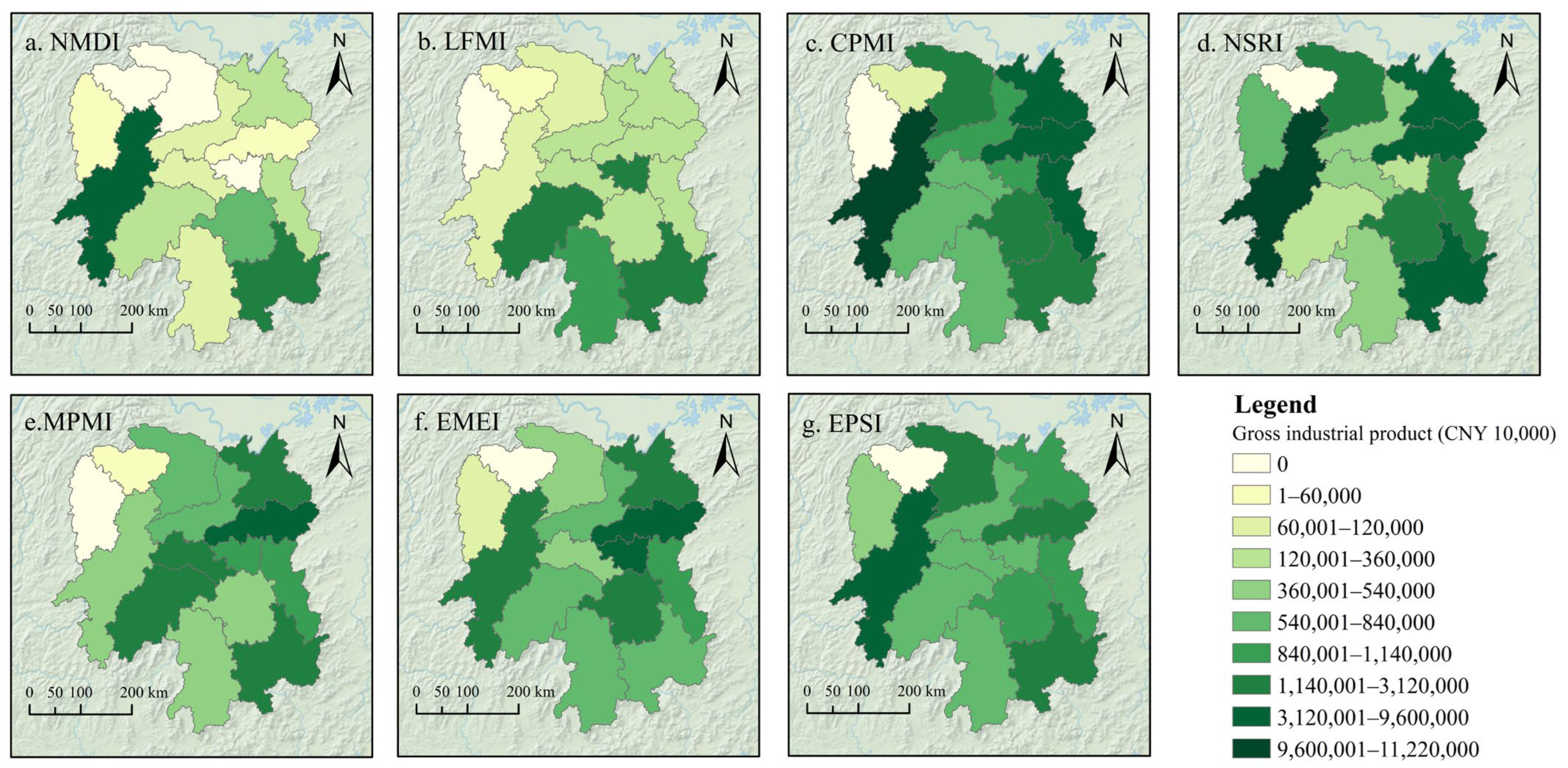
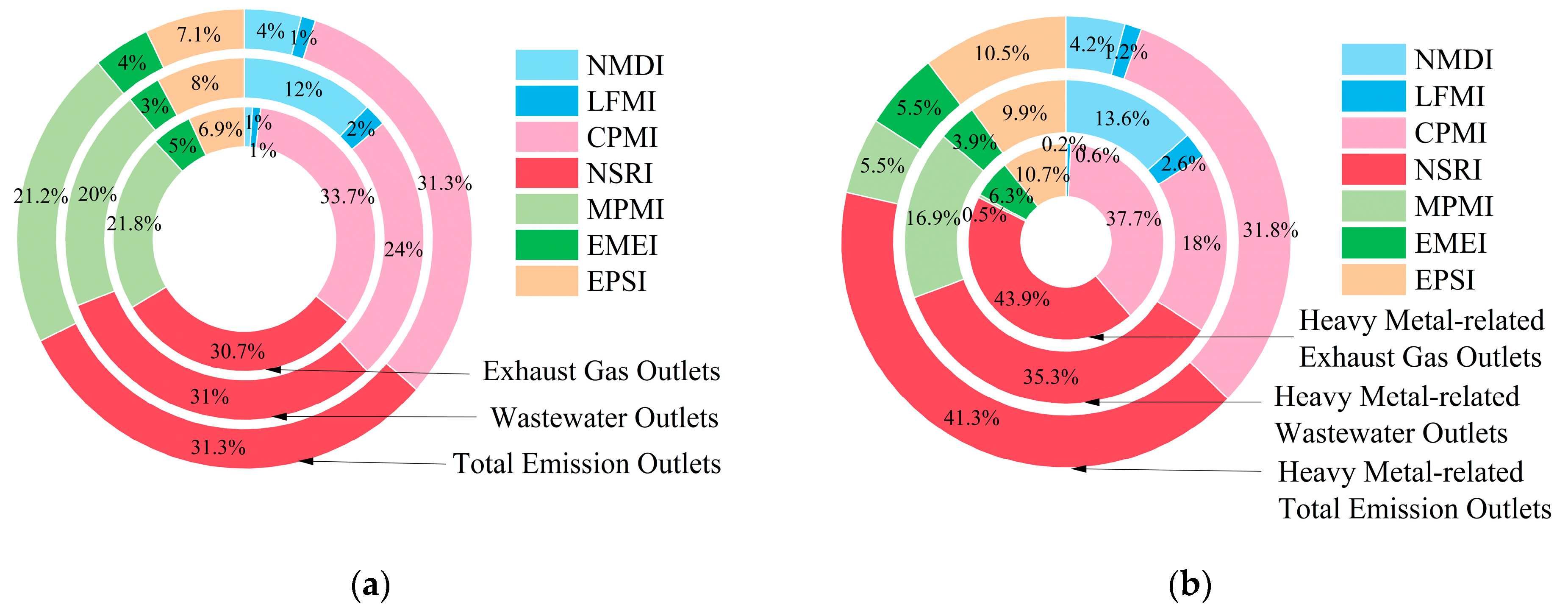

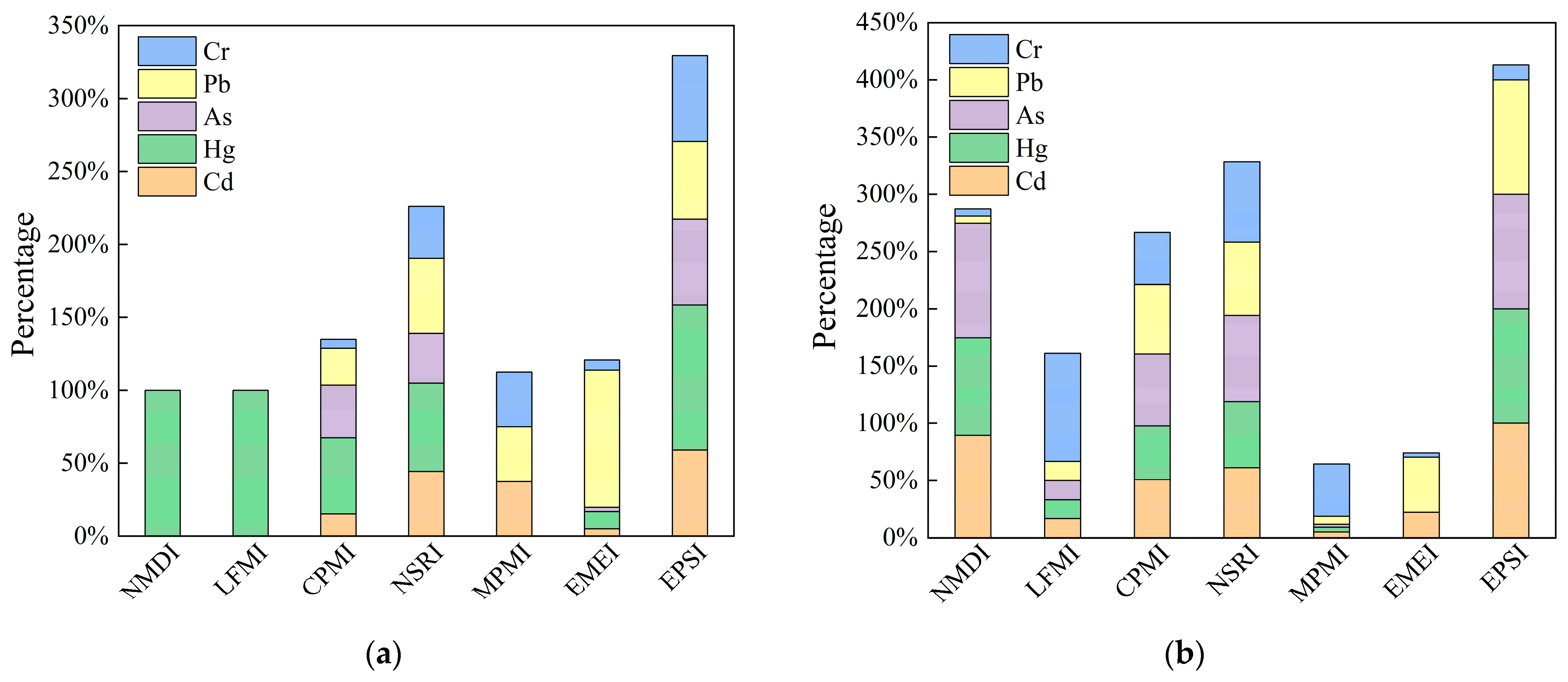
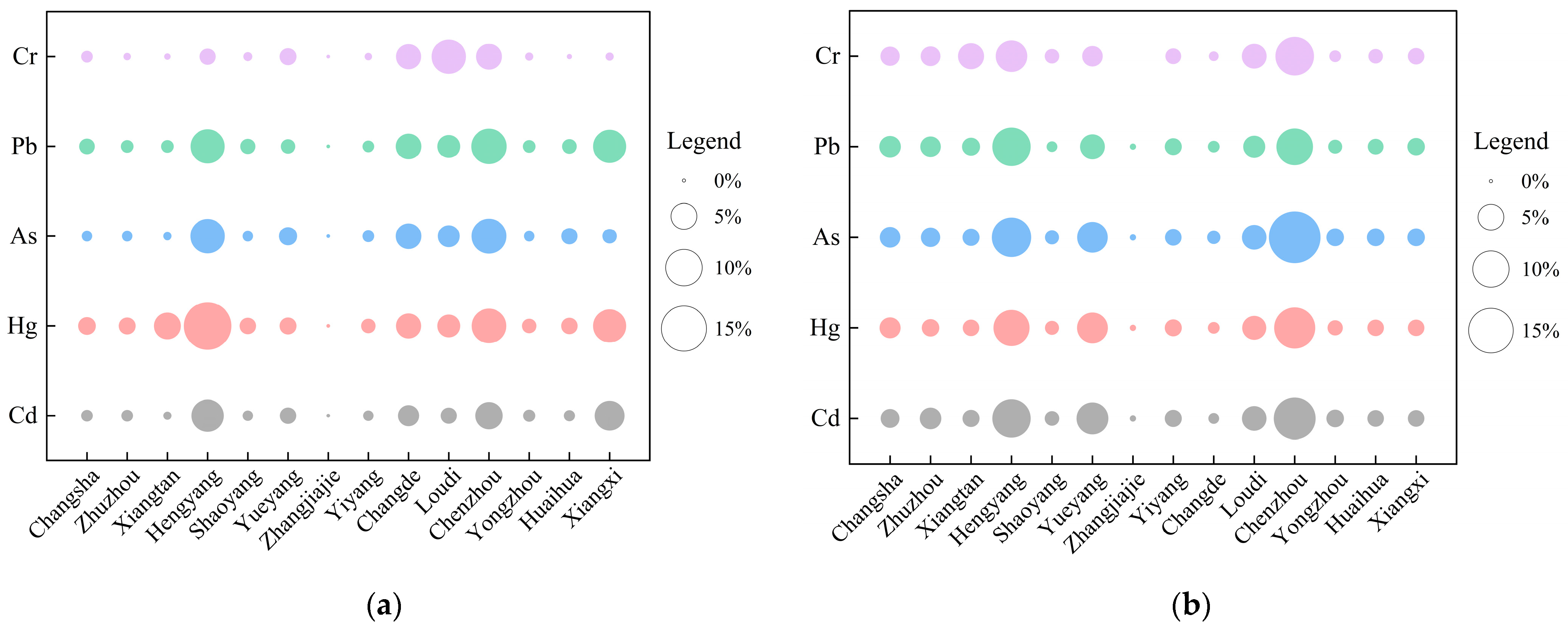
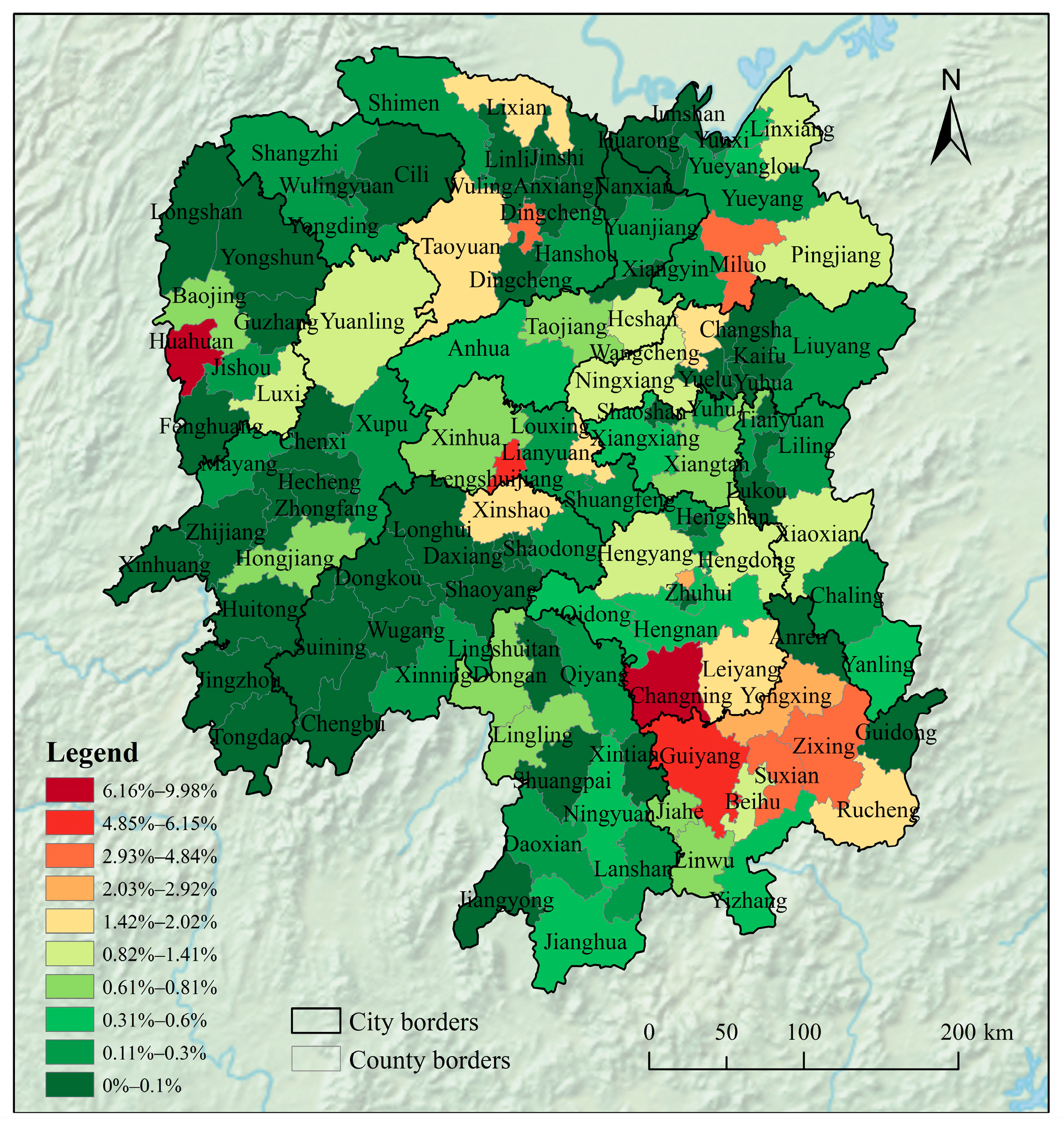

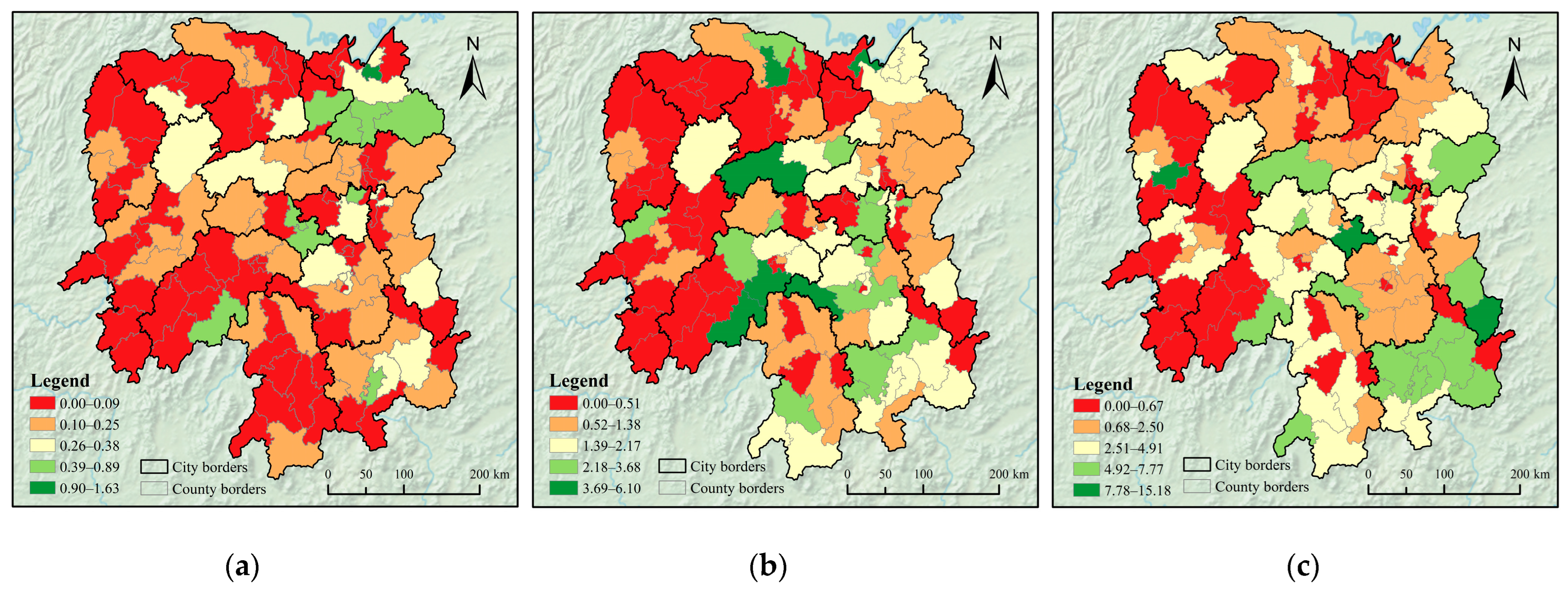
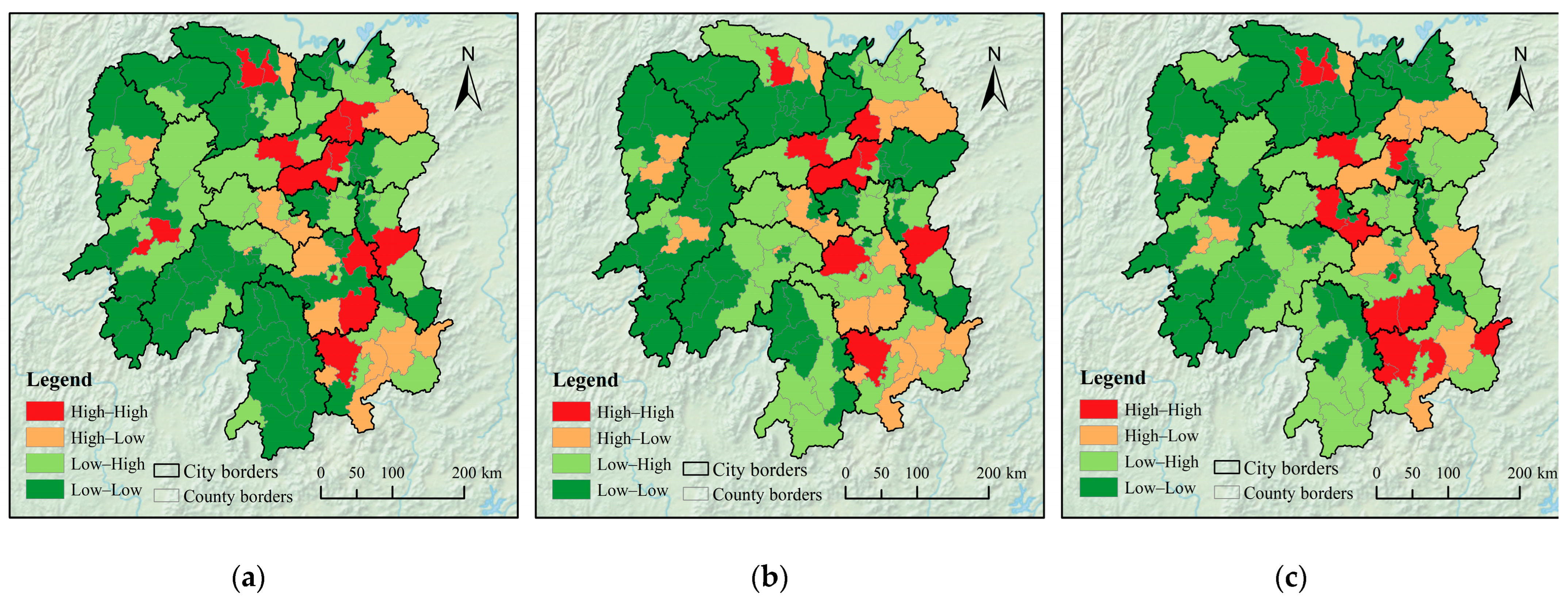
Disclaimer/Publisher’s Note: The statements, opinions and data contained in all publications are solely those of the individual author(s) and contributor(s) and not of MDPI and/or the editor(s). MDPI and/or the editor(s) disclaim responsibility for any injury to people or property resulting from any ideas, methods, instructions or products referred to in the content. |
© 2025 by the authors. Licensee MDPI, Basel, Switzerland. This article is an open access article distributed under the terms and conditions of the Creative Commons Attribution (CC BY) license (https://creativecommons.org/licenses/by/4.0/).
Share and Cite
Yang, L.; Li, X.; Luo, J.; Ma, X.; Zhang, X.; Zhao, J.; Shen, Z.; Xu, J. Spatial and Temporal Characterization of the Development and Pollution Emissions of Key Heavy Metal-Related Industries in Typical Regions of China: A Case Study of Hunan Province. Sustainability 2025, 17, 6275. https://doi.org/10.3390/su17146275
Yang L, Li X, Luo J, Ma X, Zhang X, Zhao J, Shen Z, Xu J. Spatial and Temporal Characterization of the Development and Pollution Emissions of Key Heavy Metal-Related Industries in Typical Regions of China: A Case Study of Hunan Province. Sustainability. 2025; 17(14):6275. https://doi.org/10.3390/su17146275
Chicago/Turabian StyleYang, Liying, Xia Li, Jianan Luo, Xuechun Ma, Xiaoyan Zhang, Jiamin Zhao, Zhicheng Shen, and Jingwen Xu. 2025. "Spatial and Temporal Characterization of the Development and Pollution Emissions of Key Heavy Metal-Related Industries in Typical Regions of China: A Case Study of Hunan Province" Sustainability 17, no. 14: 6275. https://doi.org/10.3390/su17146275
APA StyleYang, L., Li, X., Luo, J., Ma, X., Zhang, X., Zhao, J., Shen, Z., & Xu, J. (2025). Spatial and Temporal Characterization of the Development and Pollution Emissions of Key Heavy Metal-Related Industries in Typical Regions of China: A Case Study of Hunan Province. Sustainability, 17(14), 6275. https://doi.org/10.3390/su17146275




